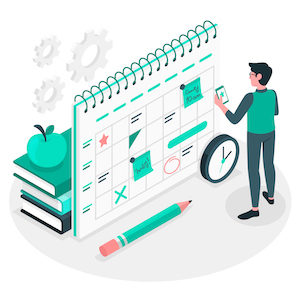When you forget the time in front of your screen, when your only way of communication is through microphones, when your head is buzzing and your tired fingers are typing on the keyboard, the overload becomes a powerful, omnipresent overlord. The personification of everything work shouldn’t be like.
The digital transformation is turning our entire lives upside down. Even though this is not a new insight, we are only gradually becoming aware of its influence on our work and private lives and its power. After all, most digital tools are actually designed to take the pressure off us. They are supposed to be user-friendly while embracing the spirit of the new working world. So is the digital really as good as we have always dreamed it would be in recent years?

As a communications consultant, co-founder and managing partner of Rethink as well as co-founder of Neuwork, Markus has been dealing with new ways of working for several years now.
How do we create a responsible and healthy approach to tools that we use every day at work and in our free time, without letting them stress us out? What else can we do to prevent an overload?
During the 40th New Work Berlin Meetup, we talked with Markus Albers about the digital downsides that are currently emerging, and how we should counter them. Markus was an early advocate of flexible working hours and remote work since 2008. Today, Markus also has a different perspective, as shown in his latest book about digital exhaustion.
The new “normal”
Our image of work is a social construction, and it has changed dramatically in the last year and a half due to the pandemic. After the initial shock wave, we now seem to have our feet back on the ground. Companies at every level are now busy planning for the post-Covid era. They have reconsidered their critical reservations and now support remote working instead of blocking it. Mobile working has had a major breakthrough and not much will change once the pandemic is over. The benefits are obvious: a better work-life balance, fewer unnecessary business trips, and time saved by not having to travel to work. This is just as evident on the executive floors as it is among employees.
To continue our collaboration and projects in the process, we resort to digital support. Tools help us in creative cooperation and constructive communication, seemingly effortlessly bridging time and space, providing transparency, self-determination and informedness.
The future of work concept also goes hand in hand with the digital transformation. A retrospective look at the last few months shows that new ways of working are becoming mainstream. But is that good? With this provocative question, Markus Albers directs the focus to the downsides of digital working: current figures show not only the acceptance of this change, but also the burdens that employees are facing. The place of work has shifted to the private sphere. Thus, the clear separation between job and private life is missing in terms of space and time. Being permanently on stand-by triggers stress. Digital exhaustion is now reaching all of us and will have a long-term impact on our health. The latest study on Zoom Exhaustion and Fatigue from Stanford University confirms this and provides quantitative data on the impact of video conferencing on participants.
Three perspectives on overload
In order to face these phenomena with solutions, Markus proposes the problem analysis and solution search in three dimensions:
- Bricks: the space, the actual physical workplace.
- Bytes: the digital, i.e. the tools and data used
- Behavior: the corporate culture, how work is experienced
Bricks – the space
What’s it about? Classic office structures with a series of individual rooms will soon be a thing of the past. Open office situations, on the other hand, lead to more interruptions, stress, difficulty concentrating and loss of motivation. So what should future workspaces look like? What functions must they fulfill?
What to do? The most important question is not asked often enough when designing new workspaces: Do we need to go back to the same presence culture at all, or can we do it differently? A quick look at the current working reality clearly shows that we are digitally moving in the same pattern as before the pandemic: We spend significantly more time in synchronous meetings for coordination and discussions than actually having effective time for creativity.
It’s important to reevaluate when it makes sense to work together and in what form. To be (there) or not to be (there) is the central question here. We should rethink workspaces for this and create rooms that are designed for different purposes: Collaboration, action, retreat, relaxation. An engaging wellbeing culture that goes far beyond providing a foosball table would be highly desirable.
In spaces used for focus work, we should mitigate noise pollution. In phone booths or small meeting rooms, people may talk loudly, while in other rooms it should be more quiet. Any person who has worked in a shared office knows this issue all too well. A stress-free and healthy workplace also includes a ventilation concept that has ideally already been designed architecturally.
In order to continue to offer employees a certain degree of freedom or to save on travel, premises outside the headquarters can be used, such as co-working spaces or satellite offices.
Bytes – the digital
What’s it about? New ways of working put a lot of emphasis on collaboration. This is digitally supported by countless tools. But an overemphasis is becoming apparent: knowledge workers spend 70-85% of their time on meetings, calls, e-mails, and collaboration apps. This makes it clear – there is too little time left for concentrated intensive work on focus tasks.
What to do? We can separate space and time, and we can do it by delaying communication. Chats are a popular example. The asynchronous use of digital channels actually creates more disruption-free times and, appropriately, also promotes a respectful use of resources. Slack & Co show the way: With the right use and adaptation, digital tools give us the opportunity to increase our individual freedom. But open, time-displaced communication naturally has its disadvantages, especially if you need an urgent answer to a question right away. Here, managers like to take the shortcut of direct communication, for example by calling their colleagues. But this quickly takes employees out of their workflow.
Markus recommends regularly checking the digital toolbox to answer the question: What do we need? In the meetup, we collected elements of digital work that we should keep, add or eliminate:
We should keep tools that connect people across different locations. We should add downtime that is clearly communicated and anchored in the corporate culture. This should prevent distractions caused by constant digital accessibility. We also recommend that you indicate the time period in which a response is desired with each question you pose to colleagues. Virtual meetings should always have a goal and be clearly structured so that, for example, there is always time at the end to summarize and validate the results. As the number of tools increases, it should be clearly defined which tools are used for what purpose, and where decisions or important materials are documented. We should eliminate unnecessary notifications and forms of communication that bring no real added value because they are used aimlessly and in an inflationary manner.
Behavior – the culture
What’s it about? Of course, all of this requires a corresponding culture with clever concepts. The shift to distributed working turns work-life balance into work-life blending. This, in turn, has unfortunately intensified the trend toward working without boundaries, because work and private life are merging in terms of time. Fixed times suddenly appear inflexible, and time-off seems old-fashioned. There is a lack of self-reflection and criticism. The result is too much screen time and hours wasted on unimportant tasks.
What to do? Setting boundaries helps us get through stressful times and builds calm and resilience. By following these rules, companies can support their employees in the virtual-first environment in terms of wellbeing, mindfulness, time management and communication.
The basic ideas for appreciative and goal-oriented communication should first be discussed and documented in every company for this purpose. The question How do we want to interact and deal with each other? is central to this. On this basis, communication rules should then be established first and foremost. These can be set up as company-wide rules and in addition individually for each person. One example would be core hours of availability for all employees, supplemented by individual availabilities. The meeting culture should also change: Instead of negotiating technical issues and interpersonal tensions at the same time in a meeting and thus condensing the content to the point of excessive tension, we recommend a clear focus. The length, the setting and the form can be determined by the content and the goals.

Careful planning can save a lot of stress and hassle. Picture from Freepik.
Manager or Maker Schedule?
How do I actually work? A look at the calendar reveals how you spend your time. It can be divided into two (extreme) types of calendars – a manager’s and a maker’s:
In the Manager’s Schedule, we see many short, quick appointments one after the other, which works well for managers who need to briefly discuss or decide something. In the Maker’s Schedule, on the other hand, there are clearly structured task areas, recurring daily routines, and blocks for concentrated work.
Our conclusion
In the meantime, the topics of awareness and mindfulness have also arrived in large companies. And socially, too, new cultural techniques are developing in dealing with digital tools, both in private life and in the world of work. Technical developments are enormous – a lot is changing and it is changing fast. Right now, therefore, we are thinking about the direction in which we want to develop digital culture. We want to actively shape how we work and live in the future. By looking at Bricks, Bytes and Behavior, every individual and company will be able to do that. This requires a critical analysis of the three perspectives from the point of view of each individual and with a view toward the organization as a whole. A successful life in the digital world also requires a lot of self-discipline. If we actively deal with the problems and opportunities of digital transformation, we will soon be able to shake hands with the overlord and say goodbye. But we will probably also wave goodbye for a while until he disappears behind the horizon.
Title image: Borja Bonaque
Our guest authors

Jens Hündling. Picture by studioafraz.com
Jens Hündling is a freelance trainer and coach for digital transformation and future of work. As a former IT executive, he prefers to communicate with people rather than machines and is passionate about developing teams and organizations. Especially with an East Frisian sense of humor. Currently Jens is a solution architect at CoachHub – The digital coaching platform. More about him at https://dr-huendling.de

Heidi Dommaschke
As a trainer, mediator and coach, Heidi Dommaschke accompanies people and organizations in change. In addition to inner work and resilience, she is particularly interested in the further development of communication and conflict competence. She is driven by the question of how we want to live and work, and how we can actively shape our environment. www.hundred-ways.com


